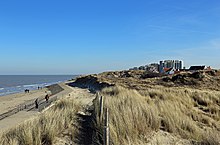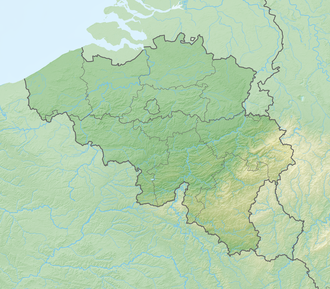Belgium
The Kingdom of Belgium (Dutch![]() , French Royaume de Belgique) is a federal state in Western Europe. It is located between the North Sea and the Ardennes and borders the Netherlands, Germany, Luxembourg and France. Belgium has about 11.4 million inhabitants (2018) in an area of 30,688 square kilometres. With 374 inhabitants per km², Belgium is one of the most densely populated countries. Belgium's level of urbanization is the highest in Europe at nearly 98 percent. The city of Brussels is the capital and seat of the Belgian royal family as well as the centre of the largest agglomeration. The most populous city is Antwerp; other major cities are Ghent, Charleroi, Liège, Bruges and Namur.
, French Royaume de Belgique) is a federal state in Western Europe. It is located between the North Sea and the Ardennes and borders the Netherlands, Germany, Luxembourg and France. Belgium has about 11.4 million inhabitants (2018) in an area of 30,688 square kilometres. With 374 inhabitants per km², Belgium is one of the most densely populated countries. Belgium's level of urbanization is the highest in Europe at nearly 98 percent. The city of Brussels is the capital and seat of the Belgian royal family as well as the centre of the largest agglomeration. The most populous city is Antwerp; other major cities are Ghent, Charleroi, Liège, Bruges and Namur.
Since independence in 1830 and constitutionalization in 1831, Belgium has been a hereditary parliamentary monarchy (see also Belgian monarchy). The north of the country with the Flemish is Dutch, the south with the Walloons French language area (see Flemish and French Community). The Brussels-Capital Region is officially bilingual, but with a majority Francophone population. In the German-speaking area of East Belgium, Standard German and West Middle German dialects are widespread (cf. German-speaking Community).
The Flemish-Walloon conflict, which has been ongoing since the 19th century, has shaped the often conflicting interests of the representatives of the two large population groups in Belgian politics. Since the 1970s, therefore, attempts have been made to counter this problem by decentralising the organisation of the state. To this end, Belgium was transformed into a federal state consisting of three regions and three communities. The regions of Flanders, Wallonia and Brussels-Capital, as well as the Flemish, French and German-speaking Communities, have since formed the basic political structure of the country. Belgium's state structure is considered to be complex because, among other things, the territories of the regions do not coincide with those of the communities. For example, the competences of the French and Flemish Communities overlap in the officially bilingual Brussels Region, and the small territory of the German-speaking Community belongs to the majority French-speaking Walloon Region.
Belgium is a founding member of the European Economic Community (EEC), now the European Union (EU), whose main institutions are based in its capital, Brussels. Belgium is also a member of the Benelux Economic Union, along with the Netherlands and Luxembourg.
Country name and overview
The name Belgium is based on the Roman province of Gallia Belgica. This northeastern part of Gaul was inhabited by tribes of Celtic (i.e. the Belgae) and Germanic (i.e. Germani cisrhēnani) origin. In the 18th century, the French adjective belge or belgique was considered the equivalent of Nederlands 'Dutch'; the short-lived independent Belgian State of 1790, for example, was called États belgiques unis in French and was usually called Verenigde Nederlandse Staten in Dutch. Later, the use of belge and belgique became increasingly restricted to the southern Netherlands, now Belgium.
From the High Middle Ages to the mid-17th century, Belgium was a hotbed of cultural and economic creativity and wealth. From the 16th century onwards, Belgium was the theatre of many battles fought by European powers, such as during the Coalition Wars and the First and Second World Wars. Belgium participated intensively in the Industrial Revolution and from 1885 to 1960 possessed the huge colony of the Belgian Congo in Central Africa, since the First World War including the adjacent territory of Rwanda-Urundi.
Geography
Geology and geomorphology
In the wake of the post-glacial Flandrian transgression, beach walls were formed, which are still present today as a closed belt of dunes up to 50 metres high along the Belgian coast. This is followed by a zone of marshland about 10 to 20 kilometres wide.
Further inland lies the so-called Flussgeest. Here the deposits of the Maas alluvial fan were covered with sands of great thickness during the last cold period. In the slightly undulating countryside, fields and meadows alternate with patches of woodland and heathland; upland moors also occur in places. To the west of an Antwerp-Brussels line is the wide Flanders plain. In its northern part it is also covered by sands, in the south clay soils dominate, which are more favourable for agriculture. Here the plain is overlooked by a loose chain of Tertiary hills. Towards the west, the plain already mediates with the Northern French stratified plain, which is largely composed of Mesozoic sediments.
The valleys of the Sambre and Meuse rivers form a sharp boundary on a tectonic fault zone separating the Tertiary and Cretaceous plateaus in the northwest from the Ardennes as part of the Rhenish Slate Mountains in the southeast. The heavily forested Ardennes are composed of variably recalcitrant Palaeozoic shales, sandstones, greywackes and quartzites. They reach a height of 694 metres in Belgium with the Botrange in the Hautes Fagnes.
The fault zone of the Haine-Sambre-Meuse furrow is rich in coal deposits. This is where the first continental European mining and heavy industry district developed from 1830 onwards.
Flanders and Brussels-Capital Region
Flanders forms the northern part of the country and consists largely of flat land. It is the most populous region of the country. The politically independent capital region of Brussels is located as an enclave within the Flemish region. This part of the country consists partly of sandy geest ridges - for example in the province of Limburg, which is located in the east of the Flemish Region. However, the Geest is also interrupted by marshlands, which particularly affects the area around the rivers. The most important of these are the Meuse and the Scheldt. In the far west of Flanders is the 65 kilometre long coastline with the port city of Ostend. Especially the provinces of Antwerp and Flemish Brabant with the surrounding area of Brussels are very densely populated.
Walloon Region
The Walloon Region covers the southern part of Belgium. It is the largest region of the country in terms of area. Its territory is mountainous and sparsely populated in the area of the Ardennes and is cut by the river valleys of the Meuse, Sambre and Ourthe. The main cities of the region are located along these rivers, in particular Liège, Namur and Charleroi. Mons, Mouscron and Tournai are also located in the west of the region, in a cross-border conurbation with the northern French city of Lille. Nil-Saint-Vincent (municipality of Walhain) in the densely populated province of Walloon Brabant is the geographical centre of Belgium. The highest elevation in the country is Signal de Botrange (694 m E.P. ) in the Hautes Fagnes in eastern Belgium near the border with Germany. The highest village in Belgium is Mürringen in eastern Belgium (655 m asl).
Numbers
|
|
25% of Belgium's land area is used for agriculture. About 95% of all Belgians live in cities. According to the calculations of the Royal Belgian Institute of Natural Sciences, Belgium has an area of 30,688 km².
Of which includes
- the Brussels-Capital Region 162 km²
- the region of Flanders 13,624 km²
- the Walloon Region 16,901 km² (including the German-speaking Community 854 km²)
Waters
Among others, there are the following rivers and canals:
|
|

Dunes at the beach of the North Sea in De Panne in the West of Flanders
Questions and Answers
Q: What is the official name of Belgium?
A: The official name of Belgium is the Kingdom of Belgium.
Q: What are the countries that border Belgium?
A: The countries that border Belgium are The Netherlands in the north, Germany to the east, Luxembourg to the southeast and France to the south.
Q: How many people live in Belgium?
A: Around 11.6 million people live in Belgium.
Q: What organizations are based in Brussels, which is the capital city of Belgium?
A: The European Union, NATO and other famous organizations are based in Brussels, which is the capital city of Belgium.
Q: What are the three regions of Belgium?
A: The three regions of Belgium are Flanders (in northern half), Wallonia (in southern half) and Brussels-Capital Region (where capital city Brussels is found).
Q: What languages do people speak in each region?
A: In Flanders most people speak Dutch; In Wallonia most people speak French; In Brussels-Capital Region French is mostly spoken with some Dutch; And there's a small part of Wallonia next to Germany where people speak German.
Q: How does Belgian government look after all these groups speaking different languages?
A:Belgium has a complicated system of government to look after all these groups speaking different languages.
Search within the encyclopedia
